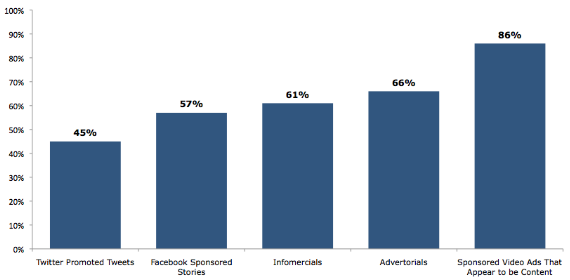
Native Advertising at a glance!
- Posted by Socialmbuzz
- On 28th April 2015
What is Native Advertising?
Native Advertising is a form of digital advertising wherein the ad matches the form and function of the platform on which it is advertised. Simplistically put, this means that the content of the advertisement blends with the original content and media on the website. The various formats of native advertising include promoted videos, images, articles, commentary etc that is stylistically similar to the original content. Social-native ads, i.e., native advertising on social media is another form of native advertising, examples of which would be promoted ads on Twitter, Facebook, Tumblr etc. Content marketing that features a sponsored section alongside the featured content is also another example of native advertising.
A number of online stores advertise such content to users based on their previous online behavior which ensures greater visibility to the relevant audience thereby undoubtedly translating into lower CPCs and increased ROI! There are different platforms such an open platform, which promotes the same branded content across different platforms; and closed platform wherein profiles or content is created within a platform and is then advertised within the confines of the same platform.
The native advertising market is booming all across the globe with increased vigor. According to a survey by the BI Intelligence native advertising stake will grow to $21 billion by 2018, in sharp contrast to the $4.7 billion in 2013!
What are the pros and cons of Native Advertising?
Native advertising also comes with its own set pros as well as cons despite being seemingly lucrative and obviously rewarding.
Listed below are the pros and cons of native advertising.
Pros:
- The trend of native advertising seems to be on an all time high as it promises lower CPCs and enhanced conversion rates!
- Social-native Ads which include ads on social networking websites and popular WebPages is witnessing a steep upward growth curve as they account for the biggest share of the native ad revenue.
- Sponsored content on related WebPages and websites is increasingly attracting attention!
Cons:
- In the case of native advertising the biggest thing at stake is the credibility of the advertisers with regards to advertising ethics. The viewers are often beguiled into mistaking the advertisement for genuine content, and may be annoyed to find out that they had been viewing a paid advertisement in the garb of authentic content! Here’s the list of the % of misleading native ads on various platforms!

- A number of users object to the monitoring of their online behavior without prior permission.
- People who are generally concerned about preserving objective journalism and maintaining the credibility of the media outlet often raise an eyebrow at the concept of native advertising!
However, the bottom line remains that a greater number of people are continually participating in online advertising as the pros are more relevant in the real time business world than the cons are, as these ads serve to gain greater revenue and consumer’s interest and are mutually beneficial to both the advertiser and the host platform!
Keep a tab on this space for more on Digital Marketing!
Click here to know why your Digital Marketing strategies are prone to being ineffective!
www.socialmbuzz.com



0 Comments